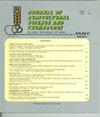Bioactive components of Erythrophleum suaveolens (Brenan) leaves extracts and their antifungal effect on Aspergillus flavus isolated from maize seeds
IF 1.3
4区 农林科学
Q2 AGRICULTURE, MULTIDISCIPLINARY
引用次数: 1
Abstract
This study set out to evaluate the phytochemical composition of Erythrophleum suaveolens leaves extract and its fungicidal attributes on Aspergillus flavus isolated from maize seeds. The leaves of E. suaveolens were collected from Gwagalada, Abuja, Nigeria, and subjected to soxhlet extraction with methanol and chloroform as solvents to determine the bioactive compounds in the leaves compared to water crude extract. Different crude concentrations of the plant extracts were added for the antifungal effect into wells within Aspergillus flavus swabbed in a potato dextrose agar plate to diffuse at room temperature for 2hrs and the plates were incubated at 28oC for 48hrs before measuring the diameter of the inhibition zones. Tannins, alkaloid, phenols, Triterpenoids, saponin, and flavonoid were present in the plant with tannin, flavonoid, saponin, alkaloid, and phenol having a concentration of 2.49, 1.448, 2.69, 0.505 and 0.366 mg/g respectively. The water, chloroform, and methanol extracts had an inhibitory diameter zone of 10 ± 0.58, 3 ± 0.58, and 0 mm, respectively at p<0.05. This study showed the presence of some bioactive compounds in E. suaveolens. Furthermore, water extract of the plant had higher antifungal potency on A. flavus isolated from maize seeds.紫红叶提取物的生物活性成分及其对玉米种子黄曲霉的抑菌作用
本研究旨在研究紫红叶提取物的植物化学成分及其对玉米种子黄曲霉的抑菌作用。在尼日利亚阿布贾的瓜加拉达地区采集沙瓦莲叶片,以甲醇和氯仿为溶剂进行索氏提取,比较水浸粗提物与沙瓦莲叶片的生物活性成分。在马铃薯葡萄糖琼脂平板上擦拭的黄曲霉中,加入不同粗浓度的植物提取物,在室温下扩散2h,在28℃下孵育48h,测定抑菌区直径。单宁、生物碱、酚类、三萜、皂苷和类黄酮含量分别为2.49、1.448、2.69、0.505和0.366 mg/g。水提液、氯仿提液和甲醇提液的抑制直径区分别为10±0.58、3±0.58和0 mm (p<0.05)。本研究表明,甜菊中存在一些生物活性化合物。此外,该植物的水提物对玉米种子中分离的黄曲霉具有较高的抑菌活性。
本文章由计算机程序翻译,如有差异,请以英文原文为准。
求助全文
约1分钟内获得全文
求助全文
来源期刊

Journal of Agricultural Science and Technology
AGRICULTURE, MULTIDISCIPLINARY-
CiteScore
1.90
自引率
8.30%
发文量
0
审稿时长
4.5 months
期刊介绍:
Journal of Agricultural Science and Technology is one of the TMU Press journals that is published by the responsibility of its Editor-in-Chief and Editorial Board in the determined scopes.
Journal of Agricultural Science and Technology (JAST) is an international research journal published bimonthly for the purpose of advancing the scientific studies. The subjects covered by JAST include all aspects of agriculture and natural resources (see Areas Covered). The journal will consider submissions from all over the world, on research works not being published or submitted for publication towards publication as full paper, review article and research note. The Papers are published in English with an extra abstract in Persian.
 求助内容:
求助内容: 应助结果提醒方式:
应助结果提醒方式:


